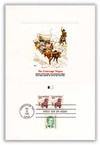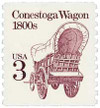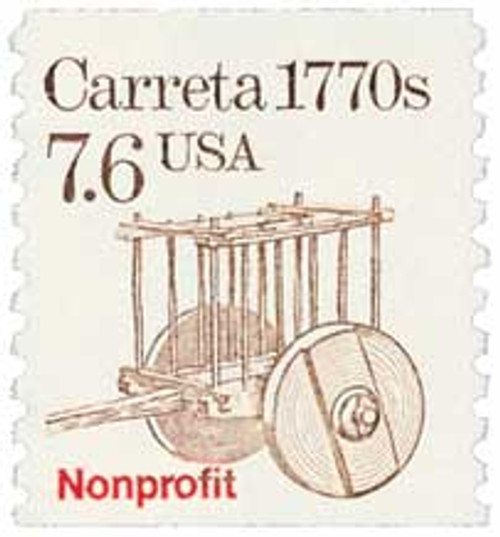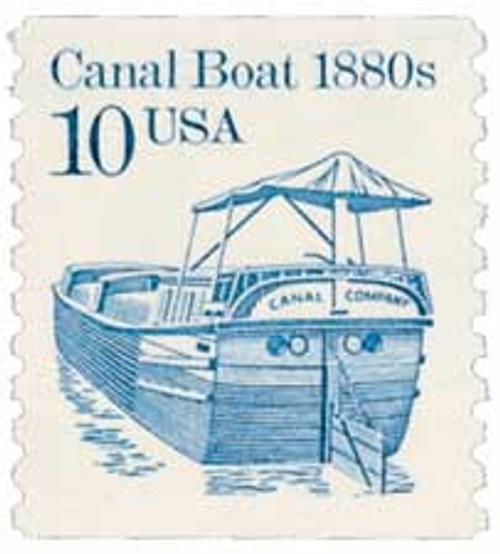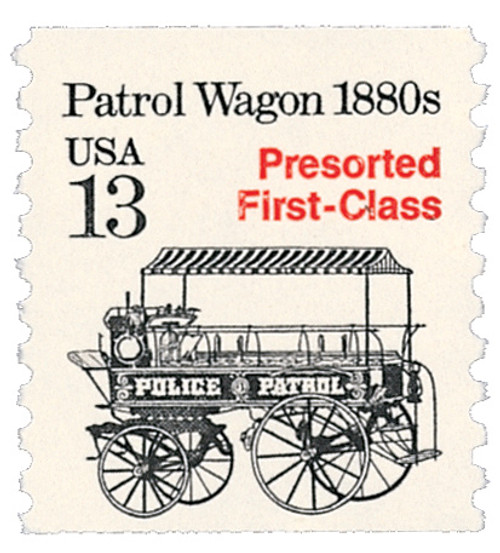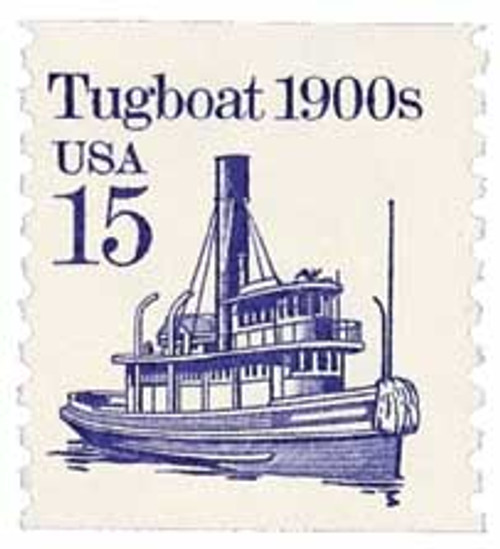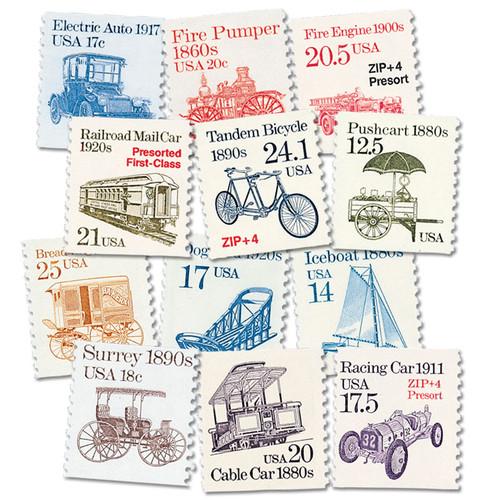
# 2252 - 1988 3c Transportation Series: Conestoga Wagon, 1800s
U.S. #2252
1988 3¢ Conestoga Wagon, 1800s
Transportation Series
- 32nd stamp in the Transportation Series
- First US postal item ever issued on Leap Day (February 29), which only occurs every four years
Stamp Category: Definitive
Series: Transportation
Value: 3¢, used for make-up postage
First Day of Issue: February 29, 1988
First Day City: Conestoga, Pennsylvania
Quantity Issued: 129,828,000
Printed by: Bureau of Engraving and Printing
Printing Method: Engraved
Format: Coils of 100, 500, and 3,000
Perforations: 10 vertical
Color: Claret
Why the stamp was issued: This stamp replaced the 1983 3¢ Railroad Handcar stamp. A new 3¢ stamp was needed to provide make-up postage for people using up old stocks of 22¢ stamps to meet the new 25¢ rate that went into effect that year.
About the stamp design: The Conestoga wagon was selected as the stamp subject as part of a reader’s poll conducted by Linn’s Stamp News. Out of 194 suggested Transportation stamp topics, the Conestoga was selected by a large margin. Richard Schlect created the image for this stamp based on a photo from the book Conestoga Wagon 1750-1870.
First Day City: The First Day ceremony for this stamp was held on the bed of a 16-foot Conestoga wagon at the Fire Hall in Conestoga, Pennsylvania.
Unusual fact about this stamp: Varieties of this stamp have been found with a vertical plate crack in the “W” of Wagon.
About the Transportation Series: On May 18, 1981, the USPS issued the first stamp in the Transportation Series, US #1907, picturing the Surrey, a doorless four-wheeled carriage. For the first time in US history, a coil stamp featured its own unique design rather than simply copying that of the current definitive stamp. Over 50 more coil stamps would be issued over the course of the next 15 years, each picturing a different mode of transportation. All of these types of transportation were used since American independence.
The various denominations provided face values to exactly match the rates for several categories of Third-Class mail (bulk rate and quantity-discounted mail). As the rates changed, new stamps with new values were added. Never before had a stamp series included so many fractional cent values.
The Bureau of Engraving and Printing printed most of the stamps in the Transportation Series, although private contractors printed a few. All but a few of the later stamps were produced by engraved intaglio. Differences in precancels, tagging, paper and gum provide a large number of varieties.
Scott Catalog separates the Transportation stamps into four groups. The stamps in the first group (#1897-1908) generally have the denomination in small type with a “c” next to it. These stamps were printed on the Cottrell rotary press, which joined together two plates to make a sleeve. The gaps between these plates created depressions where ink would collect and create joint lines on the stamps. Later issues were printed on a different press and didn’t have these joint lines.
The second group (#2123-36) had larger numbers with no “c.” The third group (#2252-66) was similar in appearance to the second group, but service inscriptions were added to the designs. These stamps also used a variety of paper and gum as well as different types of tagging. The fourth group (#2451-68) marked the end of fractional values. Now bulk mailers would use either the 5¢ or 10¢ stamp and then pay the difference from the actual postage rate.
The last stamp in the Transportation Series, the 20¢ Cog Railway, was issued on June 9, 1995, at the TEXPEX ’95 stamp show in Dallas, Texas. This marked the end of the largest US definitive series up to that time. Three new series would eventually replace it – American Transportation, American Culture, and American Scenes. Additionally, the Great Americans would go on to become the largest American definitive series.
History the stamp represents: The Conestoga wagon was created by German settlers in Lancaster County, Pennsylvania in the early 1700s. It was named after the Conestoga River and Conestoga Township. These covered wagons could carry up to six tons and were pulled by horses, mules, or oxen. The Conestoga wagon was designed so that the items inside wouldn’t move around and also to help it cross rivers and streams. The most common use was to transport produce to fairs and farmer’s markets. Its rounded, boat-like-shaped bed, high side walls, and wide-rimmed, oversized wheels later made it ideal for traveling through the Appalachian Mountains. Contrary to popular belief, these wagons were never used by settlers traveling from Oregon to California.
U.S. #2252
1988 3¢ Conestoga Wagon, 1800s
Transportation Series
- 32nd stamp in the Transportation Series
- First US postal item ever issued on Leap Day (February 29), which only occurs every four years
Stamp Category: Definitive
Series: Transportation
Value: 3¢, used for make-up postage
First Day of Issue: February 29, 1988
First Day City: Conestoga, Pennsylvania
Quantity Issued: 129,828,000
Printed by: Bureau of Engraving and Printing
Printing Method: Engraved
Format: Coils of 100, 500, and 3,000
Perforations: 10 vertical
Color: Claret
Why the stamp was issued: This stamp replaced the 1983 3¢ Railroad Handcar stamp. A new 3¢ stamp was needed to provide make-up postage for people using up old stocks of 22¢ stamps to meet the new 25¢ rate that went into effect that year.
About the stamp design: The Conestoga wagon was selected as the stamp subject as part of a reader’s poll conducted by Linn’s Stamp News. Out of 194 suggested Transportation stamp topics, the Conestoga was selected by a large margin. Richard Schlect created the image for this stamp based on a photo from the book Conestoga Wagon 1750-1870.
First Day City: The First Day ceremony for this stamp was held on the bed of a 16-foot Conestoga wagon at the Fire Hall in Conestoga, Pennsylvania.
Unusual fact about this stamp: Varieties of this stamp have been found with a vertical plate crack in the “W” of Wagon.
About the Transportation Series: On May 18, 1981, the USPS issued the first stamp in the Transportation Series, US #1907, picturing the Surrey, a doorless four-wheeled carriage. For the first time in US history, a coil stamp featured its own unique design rather than simply copying that of the current definitive stamp. Over 50 more coil stamps would be issued over the course of the next 15 years, each picturing a different mode of transportation. All of these types of transportation were used since American independence.
The various denominations provided face values to exactly match the rates for several categories of Third-Class mail (bulk rate and quantity-discounted mail). As the rates changed, new stamps with new values were added. Never before had a stamp series included so many fractional cent values.
The Bureau of Engraving and Printing printed most of the stamps in the Transportation Series, although private contractors printed a few. All but a few of the later stamps were produced by engraved intaglio. Differences in precancels, tagging, paper and gum provide a large number of varieties.
Scott Catalog separates the Transportation stamps into four groups. The stamps in the first group (#1897-1908) generally have the denomination in small type with a “c” next to it. These stamps were printed on the Cottrell rotary press, which joined together two plates to make a sleeve. The gaps between these plates created depressions where ink would collect and create joint lines on the stamps. Later issues were printed on a different press and didn’t have these joint lines.
The second group (#2123-36) had larger numbers with no “c.” The third group (#2252-66) was similar in appearance to the second group, but service inscriptions were added to the designs. These stamps also used a variety of paper and gum as well as different types of tagging. The fourth group (#2451-68) marked the end of fractional values. Now bulk mailers would use either the 5¢ or 10¢ stamp and then pay the difference from the actual postage rate.
The last stamp in the Transportation Series, the 20¢ Cog Railway, was issued on June 9, 1995, at the TEXPEX ’95 stamp show in Dallas, Texas. This marked the end of the largest US definitive series up to that time. Three new series would eventually replace it – American Transportation, American Culture, and American Scenes. Additionally, the Great Americans would go on to become the largest American definitive series.
History the stamp represents: The Conestoga wagon was created by German settlers in Lancaster County, Pennsylvania in the early 1700s. It was named after the Conestoga River and Conestoga Township. These covered wagons could carry up to six tons and were pulled by horses, mules, or oxen. The Conestoga wagon was designed so that the items inside wouldn’t move around and also to help it cross rivers and streams. The most common use was to transport produce to fairs and farmer’s markets. Its rounded, boat-like-shaped bed, high side walls, and wide-rimmed, oversized wheels later made it ideal for traveling through the Appalachian Mountains. Contrary to popular belief, these wagons were never used by settlers traveling from Oregon to California.






